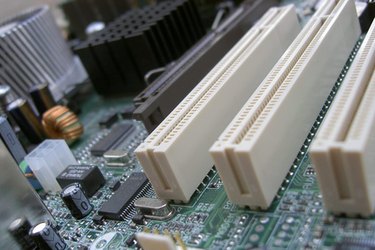
If you have ever looked at a motherboard, you've seen the PCI or PCI Express slots; these slots sit near the edge of the motherboard and allow you to remove and add new hardware to computer.
PCI
Video of the Day
Peripheral Component Interconnect (PCI) cards have remained the standard in computers for a long time as of 2010. Most computers offer several PCI slots to allow for expansion and customization. Common PCI peripherals include video cards, sounds cards and modems.
Video of the Day
PCI Express
PCI Express—sometimes abbreviated PCI-e—is a newer build that is becoming standard for computer peripherals as of 2010. PCI-e offers more variations in size and speed than traditional PCI. PCI-e cards come in four varieties: x1, x2, x8 and x16. (The larger sizes indicate faster speeds and a bigger slot.) Do not confuse PCI Express with PCI eXtended (PCI-X), an earlier build that was fully backward compatible with PCI.
Compatibility
PCI and PCI Express are not compatible; the slots have different configurations and do not fit with the cards. However, most motherboards have a combination of PCI and PCI Express cards.Do not force your card into a slot if it doesn't seem to fit; doing so may damage your hardware.